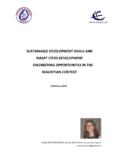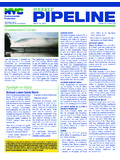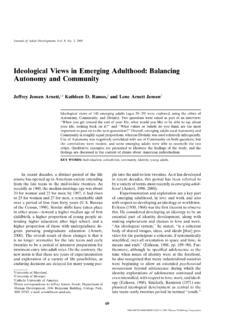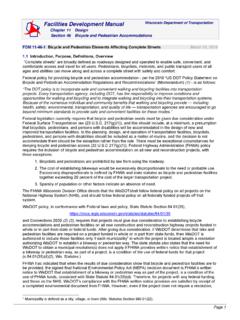Transcription of Formatted 20-SEP-2012 Final UNICEF-WHO-WB …
1 Levels & Trends in UNICEF-WHO-The World Bank Child Joint Child malnutrition estimates malnutrition This report was prepared at the World Health Organization and UNICEF by Mercedes de Onis, David Brown, Monika Bl ssner and Elaine Borghi. Organizations and individuals involved in generating the joint estimates on child malnutrition United Nations Children's Fund Tessa Wardlaw, Holly Newby, David Brown, Xiaodong Cai World Health Organization Mercedes de Onis, Elaine Borghi, Monika Bl ssner The World Bank Johan Mistiaen, Juan Feng, Masako Hiraga Special thanks go to Dr Francesco Branca, Dr Werner Schultink, and Dr Tessa Wardlaw for their support in the harmonization process and to Mrs Ann Sikanda, Mrs Florence Rusciano and Ms Stacy Young for their assistance in preparing the report.
2 Recommended citation: United Nations Children's Fund, World Health Organization, The World Bank. UNICEF- WHO-World Bank Joint Child malnutrition estimates . (UNICEF, New York; WHO, Geneva; The World Bank, Washington, DC; 2012). WHO Library Cataloguing-in-Publication Data Levels and trends in child malnutrition : UNICEF-WHO-The World Bank joint child malnutrition estimates . nutrition disorders. nutrition disorders. assessment. status. development. height. weight. I. de Onis, Mercedes. , David. ssner, Monika. , Elaine. Health Organization. Bank. ISBN 978 92 4 150451 5 (NLM classification: WS 130).
3 _____. The United Nations Children's Fund, the World Health Organization and the World Bank 2012. All rights reserved. The World Health Organization and UNICEF welcome requests for permission to reproduce or translate their publications whether for sale or for noncommercial distribution. Applications and enquiries should be addressed to WHO, Office of Publications, through the WHO web site ( ) or to UNICEF (Three United Nations Plaza, New York, New York 10017 USA). The designations employed and the presentation of the material in this publication do not imply the expression of any opinion whatsoever on the part of the United Nations Children's Fund (UNICEF), World Health Organization (WHO) or the World Bank (WB).
4 Concerning the legal status of any country, territory, city or area or of its authorities, or concerning he delimitation of it s frontiers or boundaries. Dotted lines on maps represent approximate border lines for which there may not yet be full agreement. Areas masked in grey correspond to disputed territories and non-self-governing territories. While every effort has been made to maximize the comparability of statistics across countries and over time, users are advise d that country data may differ in terms of data collection methods, population coverage and estimation methods used.
5 Differences between the estimates presented in this report and those in prior and forthcoming publications may arise because of differences in re porting periods or in the availability of data during the production process of each publication and other evidence. All reasonable precautions have been taken by UNICEF, WHO and the World Bank to verify the information contained in this publication. However, the published material is being distributed without warranty of any kind, either express or implied. The responsibility for the interpretation and use of the material lies with the reader.
6 In no event shall the United Nations Children's Fund, World Health Organization or World Bank be liable for damages arising from its use. Because of the cession in July 2011 of the Republic of South Sudan by the Republic of the Sudan, and its subsequent admission to the United Nations on 14 July 2011, disaggregated data for the Sudan and South Sudan as separate States were not yet available for this report. Aggregated data presented are for the Sudan precession. Photo credits Cover page: Photo taken in Niamey, Niger. UNICEF/NYHQ2012-0156/Nyani Quaryme, 2012.
7 Pg 2: Photo taken in Louboutigu village in the Sila Region, Chad. UNICEF/NYHQ2011-2162/Patricia Esteve, 2011. Pg 3: Photo taken in the Maldives. WHO/Adelheid W. Onyango, 2005. Pg 4: Photo taken in Sholapur District in Maharashtra State. UNICEF/NYHQ2005-2395/Anita Khemka, 2005. Pg 5: Photo taken in Kibati, Democratic Republic of the Congo. WHO/Christopher Black, 2008. Pg 8: Photo taken in Honiara, Solomon Islands. WHO/Mercedes de Onis, 2010. KEY FACTS AND FIGURES. Stunting Globally, an estimated 165 million children under-five years of age, or 26%, were stunted ( , height-for-age below 2 SD) in 2011 a 35% decrease from an estimated 253 million in 1990.
8 High prevalence levels of stunting among children under-five years of age in Africa (36% in 2011) and Asia (27% in 2011) remain a public health problem, one which often goes unrecognized. More than 90% of the world's stunted children live in Africa and Asia. Underweight Globally, an estimated 101 million children under-five years of age, or 16%, were underweight ( , weight-for-age below 2SD) in 2011 a 36% decrease from an estimated 159 million in 1990. Although the prevalences of stunting and underweight among children under-five years of age worldwide have decreased since 1990, overall progress is insufficient and millions of children remain at risk.
9 Wasting Globally, an estimated 52 million children under-five years of age, or 8%, were wasted ( , weight-for-height below 2SD) in 2011 a 11% decrease from an estimated 58 million in 1990. Seventy percent of the world's wasted children live in Asia, most in South-Central Asia. These children are at substantial increased risk of severe acute malnutrition and death. Overweight Globally, an estimated 43 million children under-five years of age, or 7%, were overweight ( , weight-for-height above +2SD) in 2011 a 54% increase from an estimated 28 million in 1990.
10 Increasing trends in child overweight have been noted in most world regions, not only developed countries, where prevalence is highest (15% in 2011). In Africa, the estimated prevalence under-five overweight increased from 4% in 1990 to 7% in 2011. The prevalence of overweight was lower in Asia (5% in 2011) than in Africa, but the number of affected children was higher in Asia (17 million) than in Africa (12 million). Proper nutrition contributes significantly to declines in under-five mortality rates. Improving nutritional status is essential for achieving the Millennium Development Goals (MDGs).

















